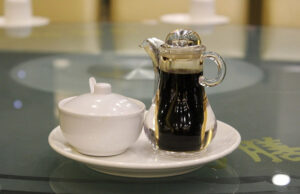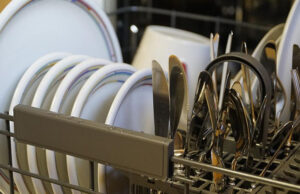There are many mysteries in the kitchen. There are several fundamental principles that any cook, experienced or novice, has to understand. It’s basic cooking advice. Do you know if can we put glass in the oven? Is it secure? If you make the wrong decision in this situation, more than just a mess could result. You might create a risk to your safety.
Fortunately, we have you covered. In this comprehensive article, we’ll address the query “can you put glass in the oven” and provide you with some helpful pointers.
Table of Contents
Can We Put Glass In The Oven?
You need to be aware of the facts before you start heating things up. Let’s summarize what you should know: All glassware is not heat-resistant.
It could be quite harmful to assume that it is. But some glass products, like Pyrex bowls and casserole dishes, might withstand heat up to a certain point. For instance, using tempered glass in the oven is typically safe. This kind of glass is four times stronger than “regular” glass, claims Scientific American. This is due to the fact that tempered glass breaks into tiny, inconsequential shards rather than massive ones.
Consequently, how is tempered glass made? A good query. While you don’t need to comprehend every aspect of tempered glass, the short explanation is that it goes through a heating process followed by a quick cooling procedure known as “quenching.” The latter procedure uses high-pressure air that is focused on the glass and only lasts a few seconds. As a result, the glass’s center maintains tension while the exterior layer continues to be compressed.
Even though tempered glass is much more durable than plain glass, you should always conduct your research. Never assume that a certain glass item is safe to use in the oven. Instead, examine each glass separately first.
Read More: Why Do They Call It Oven?
How to Judge Whether The Glass Is Oven-Safe?
Let’s discuss how to determine whether a product is oven-safe now that you are aware of the many types of glass. There are several methods you may use to check things out, regardless of whether you’re using ramekins, plates, dishes, Tupperware, or pans. It need not be difficult to determine if you have safe glass cookware at home. These three techniques can let you test it.
1. Verify for the oven-safe icon
First things first, see if the glassware is marked with an oven-safe emblem. Consider the scenario where you wish to bake something in a glass baking dish. However, take a minute to examine the product to see whether it has any symbols before doing that. These symbols are frequently inscribed on the underside of the product.
But your question, “What does the oven-safe emblem mean?” The bowl inside of an oven with heat waves rising is the oven-safe symbol. However, since it is not widely recognized, not all oven-safe glassware products will bear this specific label. For instance, if your glassware is imported, it can be marked with a completely different sign. You might also see several versions of the logo or even just plain text that reads, “oven-safe goods.” As a result, give it a look as your initial stop.
2. Review the manual or user guide
Are you utilizing a brand-new glass item? You might have the user guide or manual stashed away in a drawer if you just acquired the item. It’s good news, then! To find out if the glassware can be used in the oven, consult this literature. In some circumstances, you’ll find that the glassware products’ heating instructions are included.
3. Make use of Google
There is a last resort if you have an older glassware product: Google. You can examine the business website if you are aware of the product’s brand, such as Pyrex. Naturally, it could take you some time to locate the precise item on their website. But if you’re fortunate enough to get it correctly, you should see all the data you require
How to Prevent Glass from Breaking in the Oven
Keeping your glass container from shattering when heated in the oven is not that difficult. You only need to take a few steps in order to securely heat your meal in a glass.
- Avoid dramatic temperature changes
Glass cookware struggles to adapt to temperature fluctuations. It’s better to move glass from room temperature to a preheated oven when placing it in one. Never go straight to the oven from the refrigerator or freezer. Despite the fact that many people accomplish this without incident, you run the risk of glass shattering.
The same idea holds true when removing your glass dish from the oven. Put it on a warm surface only. Instead, put it somewhere warm or at room temperature, like a hot pad.
- Use tempered glass
Not all glass can be used in ovens. Use an only glass that has been tempered or that bears an oven-safe label. Be sure to keep the temperature of an oven-safe glass container below the limit, which is frequently listed.
Never place drinking glasses or smaller glass bowls in your oven unless they are specifically marked as oven safe because they are normally not intended to withstand oven temperatures. The lids on your glass dishes are the same way. Check the labeling to make sure they may be used in the oven.
- Keep temperatures low
Make sure to follow the manufacturer’s specified upper-temperature limit when using oven-safe glass. This temperature limit could be between 350 and 500 degrees Fahrenheit but aim to keep much below it to be safe.
- Finding structural weaknesses is step four.
When using glass cookware, always check the glass to make sure there are no little chips or scratches. Glass with cracks or scratches is weaker and more prone to breaking when temperatures change.
- For dry foods, add liquids to the bottom
It is advised to pour a tiny amount of water into the bottom of the pan when baking dry goods in a glass pan. This is due to the fact that while the dry food cooks, it will probably release some water content, which will eventually make its way to the glass’ surface.
You don’t want this water to come into touch with the hot surface of the glass since it may still be chilly. You can allow the water to warm up as the glass is heated by adding a small layer of water to the bottom layer of the glass.
The Benefits of Heating Food in Glass Containers
Why then do we ever use glass? It might be your only choice, but even if that’s not the case, there are a number of reasons why it appeals to you.
- Non-Toxic
Glass bakeware is non-toxic, unlike other materials with non-stick surfaces that are known to produce toxins at higher temperatures. One of the main reasons to cook with glass is that so many people nowadays are looking for methods to reduce the pollutants and chemicals in their lives.
- Holds the heat longer
The advantage of glass is that it maintains heat longer than conventional bakeware, which may make up for its longer heating time. It is therefore perfect for serving food in, keeping it warm for you and your guests.
- Clear surface
The ability to plainly observe the contents of your food as it cooks is a pleasant perk of baking using glass. Other forms of bakeware just allow you to see the top surface, which makes figuring out how long to cook your food difficult.
- Simple to clean
Using glass to heat your meal has this advantage even though it doesn’t relate to heating the food itself. Glass is non-porous and very simple to clean, in contrast to several other options for bakeware.
- Can be used for repeating and storage
You have to transfer your leftovers to another container for storage when using other cookware. That’s not the case with glass. You can place your glass container in the refrigerator or even the freezer as long as you give your meal plenty of time to cool completely. Foods can be warmed up in the same glass container as well.
FAQ
- Does heat cause glass to explode?
Glass is a strong substance. That implies that it won’t blow up under normal temperatures. For instance, if you leave some glassware in the sun during the summer, you should notice that it warms up without becoming too hot to hold up. However, a lot of glassware isn’t designed to resist abnormal heat, like that from an oven. You might find that this glass experiences a thermal crack and can explode if it heats up too much.
- What temperature will cause the glass to break in the oven?
The sort of glass you are using will determine the response. Therefore, before putting glass in the oven, you should always refer to the manufacturer’s instructions. You might discover that thin glass will shatter at 150 to 200 degrees. Glassware that is oven-ready and thicker might be able to endure higher temperatures. Never take anything in this place for granted.
- Can we put a glass lid in the oven?
It’s likely that any glass lid you use for pots and pans can be safely placed in the oven. This is due to the fact that these covers are frequently constructed of sturdy glass that is thick and can resist temperatures of about 200°C. As always, you might wish to double-check the product details in the directions or user manual.
- Can glass be placed in any sort of oven?
Perhaps, but make sure the glassware is heat resistant. You must be sure the item is constructed of ovenproof glass, whether it be a baking dish, a glass plate, or even ramekins. To learn this, you should carefully examine the product.
- Can you safely heat cold glass?
You might want to pause before putting a glass plate or dish in the oven or microwave if you keep them in the refrigerator. The material could be under a lot of pressure due to the sudden temperature shift from cold to hot and crack or even fracture.
- Can you bake with a glass of liquid?
The use of drinking glasses and even glass coffee mugs in the oven is not recommended. This means that you shouldn’t use any oven to place this glassware in. Additionally, these glasses are probably thin, which makes them more prone to breaking. Use a different vessel for the task to keep both you and your glasses safe.
Summary
Glass makes excellent cooking, warming, and storing medium for your food. Although glass can break in the oven, this only happens if you don’t take the necessary safety measures.
The two most important things to keep in mind when heating food in glass containers are to utilize tempered glass and to avoid making rapid temperature changes. You shouldn’t have any issues placing your glass in the oven as long as you stick to these simple instructions.


